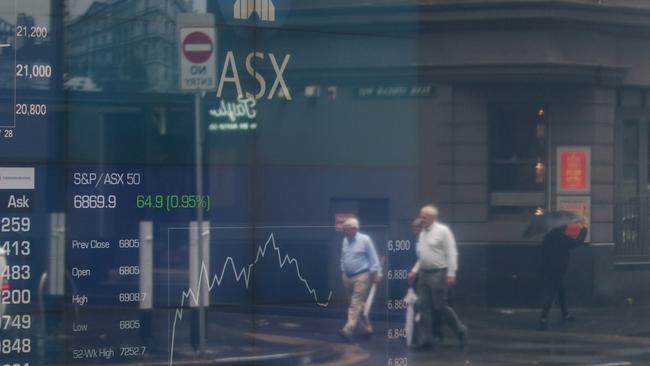Markets outlook uncertain in fog of war
The outperforming Australian share market and sagging offshore markets may converge if events in Ukraine take a different course.

Business
Don't miss out on the headlines from Business. Followed categories will be added to My News.
Convergence between the outperforming Australian sharemarket and sagging offshore markets could be a feature of the coming days, although the Ukraine/Russia situation is fluid.
After a 3 per cent fall in the S&P 500 – its worst day in 17 months – Australia’s S&P/ASX 200 index fell 0.8 per cent to a six-day low of 6980.3 points.
For the year to date the ASX 200 is down 6.2 per cent versus 12 per cent for the S&P 500 in local currency terms and 12.8 per cent for the MSCI World index.
Russia’s offer to end the war if Ukraine amends its constitution to reject joining NATO and also recognises Crimea as Russian, and Donetsk and Luhansk as sovereign states, was a surprisingly good offer versus Western assumptions that it wants at least the whole of Ukraine. It’s also better than splitting Ukraine into east and west.
It’s a long shot based on the current stance of Ukraine and the West, but at least Russia was willing to cut a deal. If it were accepted, it would certainly hurt commodity prices and help oil-dependent global markets at the expense of the commodity-rich local sharemarket.
“If true, it at least shows Putin is looking to stop the war,” said Bell Potter’s head of institutional sales and trading, Richard Coppleson.
“At this stage, with the fog of war, no one really has much idea what is happening or how this will end, but if it was to come to an abrupt end and the agreement above was the one that was eventually agreed to – then the sharemarket will rally hard off these levels.”
Commodities would of course retreat in this scenario given the importance of Ukrainian and Russian supply, but prices will stay relatively elevated while Western sanctions on Russia remain.
“With this report, some who have been in these commodity trades and made a lot of money fear that a resolution would see the commodity complex drop in the short term as it is the most overcrowded trade in the market,” Mr Coppleson added.
“As a result we saw some happy to ignore the rise in commodity prices recently and start to take some profits, and some maybe also putting on a few tentative short positions.
“But the base case for many right now – from what they can see – is that this war will drag on.”
Another way that some convergence between Australian and offshore markets could occur would be in a scenario where commodity prices peaked after having adjusted for a freezing out of Russian and Ukrainian supplies and building in a potential demand slowdown amid rising interest rates and excessively high commodity prices.
The sticker shock is about to be felt in Australian fuel.
This scenario could be magnified in the event of a global financial crisis.
But while markets remain on edge across all asset classes, inflation expectations are shooting up and funding spreads are widening, analysts aren’t overly concerned at this point in time.
Interestingly, the resources sectors suffered the biggest falls in the Australian market on Tuesday despite big gains in commodity prices on Monday.
The ASX 200 Energy sector fell 3.6 per cent and materials also fell 3.6 per cent, so they effectively stopped reacting positively to good news.
Nickel Mines was the worst performing stock in the top 200, forming a bearish key reversal pattern as it fell 11 per cent to $1.48 after rising 8.8 per cent to a record high of $1.79.
The market seemed to expect a major top on London Metals Exchange nickel after it rose 90 per cent intraday to a record high of $US53,513 a tonne before closing up 69 per cent at $US48,211.
Russia produces about 7 per cent of the world’s nickel and Tuesday’s surge squeezed short positions.
Another commodity suffering a big intraday reversal was aluminium. LME aluminium fell 3.7 per cent to $US3733 a tonne after hitting a record high of $US4090 – another bearish key reversal pattern. Russia makes about 6 per cent of the global aluminium.
It was a similar story in crude oil although it remained buoyant amid continuing pressure to ban Russian imports.
Brent rose 18 per cent to a record high of $US139.13 a barrel early Monday after the US said it was discussing with European partners a ban on Russian crude oil imports.
Most of that rise evaporated as Brent closed up 4.3 per cent at $US123.21 on Monday after Germany said it wouldn’t participate in a Russian oil ban and would focus on “sustainable” measures.
Brent rose more than 3 per cent in Tuesday’s Asia session after US politicians announced the outline of bipartisan legislation for a ban – with no plan for alternative supplies, even though renewed onshore drilling or increased Saudi supplies are possible.
Still, that didn’t stop a pullback in oil producers, with Woodside Petroleum down 5.2 per cent.
Iron ore miners also performed badly, with BHP down 3.7 per cent, Rio Tinto down 4.3 per cent and Fortescue down 4.5 per cent, even after spot iron ore rose 6.8 per cent to an eight-month high of $US162.72 a tonne.



